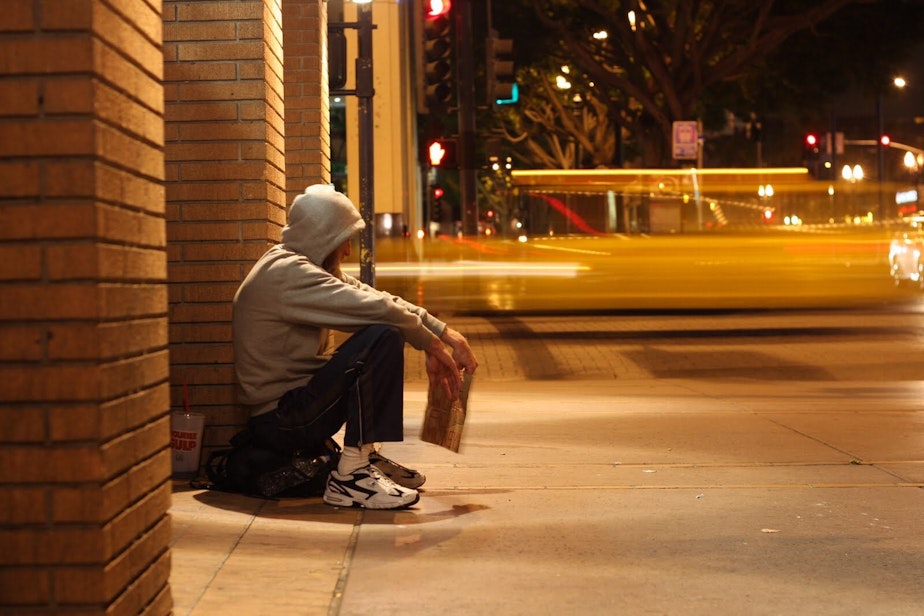Fewer homeless people in Seattle area than last year, one-night count reports

For the first time in years, the results of King County’s annual tally of people experiencing homelessness has gone down.
On a single night this January, 11,199 individuals were counted in places like shelters, tents, vehicles and on the streets.
That’s an 8% decrease over the 2018 results, when 12,112 people were counted on a single night.
It was 2012 the last time the county saw a reduction in homelessness in the one-night count, formerly referred to as a point-in-time count.
Officials caution that this data only represents a snapshot of the issue and is not a comprehensive view of what’s happening in Seattle and King County.
“We know this is an undercount,” said Kira Zylstra, acting director of All Home King County, the organization that runs the yearly count.
“Year-round data show that this crisis is much larger than just the point in time count shows,” Zylstra said.
The results come as public frustration around the homelessness crisis has reached a fever pitch. Visible signs of the crisis – people sleeping in tents, on the streets and in vehicles – have become a source of fierce debate.
Sponsored
However, the results of the 2019 tally show far fewer people living in those conditions this year over last. The street population decreased by 17 percent, according to the topline figures released by the county.
Zylstra acknowledges this may not mesh with what people perceive in their neighborhoods.
“I know that is certainly not the felt reality,” Zylstra said.
Still, with decreases counted across multiple populations, including veterans, families with children, unaccompanied young people and those experiencing chronic homelessness, officials said the results of the 2019 count indicate progress.
“We are encouraged by trends,” Zylstra said.
Zylstra’s organization has seen downward trends in the veteran population and for unaccompanied youth and young adults.
Sponsored
That indicates actions taken for these populations are working, Zylstra said, including initiatives like service providers creating lists of the names of each individual in those populations known to be homeless, or seeking services, in order to tailor services to each person’s situation.
“We do believe that these efforts are making a difference,” Zylstra said.
But this year’s count also revealed more disproportionality, too. People of color continue to be overrepresented, making up more than half those estimated to be homeless on a single night.
Homelessness went up among African Americans. The white population decreased.
The 2019 numbers also show a huge increase in the estimated number of American Indian or Alaska Native individuals who are homeless, up from 398 people in 2018 to 1,161 people in 2019.
Native American leaders criticized last year’s numbers, saying they were a dramatic undercount of people experiencing homelessness in their community.
Zylstra said this data is dependent on surveys administered after the one-night-count, and her organization worked closely with the Native community this year to ensure that it was a part of the process.
Sponsored
She acknowledged the point-in-time count has limitations and stressed it’s important to use multiple sources of data to get a picture of what’s happening in the region.
And, despite the apparent decreases, officials are by no means claiming victory.
“More than 11,000 people without a permanent place to be at night is far too many and unacceptable so we don’t treat this as a celebration, but truly as a time to take action,” Zylstra said.
Nevertheless, progress has been made, Zylstra added.
More than 500 new shelter beds were added in Seattle and King County in 2018.
Sponsored
Data also shows that more people are getting help from homeless services and more people are getting into permanent housing each year.
But officials say the number of people becoming homeless still outpaces the gains being made within the system.
“We have a lot more to do and hard work ahead of us,” Zylstra said.
As King County released the topline results of the 2019 point-in-time count, it also updated its website tracking progress on homelessness in the region to give the public a better understanding of what the crisis looks like over the course of a year, instead of on a single night.
Data on this site is pulled from the county’s Homeless Management Information System (HMIS), which tracks people who are homeless and accessing services at any point throughout the year.
Sponsored
Unlike the one night count, it doesn’t count people who are homeless but not getting any services.
This data confirms that the scope of the crisis extends beyond the numbers captured on a single night each year.
Just days after the 2019 one-night count recorded 11,199 people experiencing homelessness, HMIS data showed more than 13,000 households – which can contain one individual or multiple people – needed homeless services on a single day.
A more comprehensive report based on the surveys conducted following the 2019 one-night count is set to be released at the end of May.
That report will give a more detailed look at where people are homeless in the county, who they are, where they’re from and what they reported as the primary cause of their homelessness.




